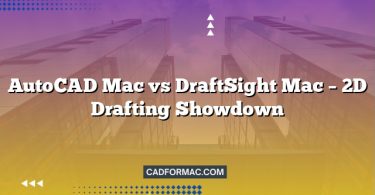Creating a professional and accurate floor plan is essential for architects, interior designers, engineers, and DIY enthusiasts alike. AutoCAD for Mac offers a powerful, industry-standard platform to produce detailed architectural drawings right from your Apple device. While the Mac version shares many features with its Windows counterpart, it has a unique interface tailored to macOS. This step-by-step guide will walk you through drafting a complete floor plan using AutoCAD for Mac—from initial setup to final annotation.
1. Prepare Your Workspace
Before you begin drafting, configure AutoCAD for optimal performance:
- Launch AutoCAD for Mac and start a new drawing (
File > New). - Choose an appropriate template. For architectural work, select
acad.dwtoracadiso.dwt(metric). These templates include standard layers, text styles, and dimension settings. - Set your units: Go to
Format > Units. Choose Architectural (for feet/inches) or Decimal (for metric), and set precision (e.g., 0′-0 1/8″ or 0.00 mm).
2. Set Up Layers
Organizing your drawing with layers improves clarity and editing efficiency:
- Open the Layer Properties Manager (
Format > Layeror typeLAYER). - Create layers for:
- Walls (e.g.,
A-WALL) - Doors (
A-DOOR) - Windows (
A-WINDOW) - Dimensions (
A-DIMS) - Furniture (
A-FURN) - Text/Annotations (
A-TEXT)
- Walls (e.g.,
- Assign distinct colors to each layer for visual distinction (e.g., red for walls, blue for doors).
3. Draw the Exterior Walls
Start with the building’s outer shell:
- Switch to the Walls layer.
- Use the Line (
LINE) or Polyline (PLINE) command. - For precision, enable Ortho Mode (
F8or click the Ortho button) to constrain lines to horizontal/vertical directions. - Input dimensions directly (e.g., type
30'and press Enter to draw a 30-foot wall). - Close the shape using the Close option in the Polyline command or by connecting the last point to the first.
Tip: Use Object Snap (OSNAP) (
F3) to snap to endpoints, midpoints, or intersections for accuracy.
4. Add Interior Walls
- Stay on the Walls layer or create a sub-layer like
A-WALL-INT. - Use Offset (
OFFSET) to quickly create parallel interior walls (e.g., offset exterior walls by 4″ or 100mm for standard stud walls). - Trim excess lines with the Trim (
TRIM) command.
5. Insert Doors and Windows
AutoCAD for Mac includes pre-made blocks or you can draw them manually:
Doors:
- Switch to the Doors layer.
- Draw a door swing using an arc (
ARC) and a line for the door leaf. - Alternatively, use the DesignCenter (
Tools > Palettes > DesignCenter) to insert standard door blocks.
Windows:
- On the Windows layer, draw rectangles within wall openings.
- Use Hatch (
HATCH) with a “glass” pattern or simply leave as open rectangles with center lines.
Pro Tip: Create reusable blocks for common doors/windows (
Insert > Block > Create) to save time.
6. Add Rooms and Fixtures
- Switch to the Furniture layer.
- Use basic shapes (
RECTANG,CIRCLE,POLYLINE) to represent:- Cabinets
- Sinks
- Toilets
- Beds
- Tables
- Maintain scale—e.g., a standard bed is 6′ x 3′ (1800mm x 900mm).
You can also download or create custom blocks for appliances and fixtures via the Tool Palettes (View > Palettes > Tool Palettes).
7. Dimension Your Plan
Accurate dimensions are critical:
- Switch to the Dimensions layer.
- Use the Linear Dimension (
DIMLINEAR) tool to annotate wall lengths, room sizes, and door/window placements. - Adjust text size and arrow style via
Format > Dimension Style.
Best Practice: Place dimensions outside the floor plan to avoid clutter.
8. Add Text and Labels
- Use the Text (
TEXTorMTEXT) command on the Text layer. - Label each room (e.g., “Kitchen,” “Master Bedroom”).
- Include a title block with project name, scale, date, and your name (insert via
Insert > Blockor draw manually).
9. Final Checks and Plotting
Before finalizing:
- Audit your drawing: Run
AUDITto fix errors. - Purge unused items:
PURGEremoves unused layers, blocks, and styles. - Check layer visibility: Freeze or turn off non-essential layers for clarity.
To print or export:
- Go to
File > Print. - Select a paper size (e.g., 11×17 or A3).
- Set the plot scale (e.g., 1/4″ = 1′-0″ or 1:50).
- Choose PDF as the printer to create a digital copy.
10. Save and Share
- Save frequently (
Cmd + S). - Use AutoCAD Drawing (.dwg) format for editing or PDF for sharing with clients.
- Consider using Autodesk Docs (via Autodesk Account) for cloud collaboration.
Frequently Asked Questions (FAQ)
Q1: Is AutoCAD for Mac the same as AutoCAD for Windows?
A: While both versions share core functionality and file compatibility (.dwg files work seamlessly across platforms), the Mac version has a native macOS interface and lacks some Windows-exclusive features—such as the full Express Tools suite, Sheet Set Manager, and certain 3D modeling tools. However, for 2D floor plan drafting, AutoCAD for Mac is fully capable and optimized for Apple hardware.
Q2: Can I use AutoCAD LT for Mac to create floor plans?
A: Yes! AutoCAD LT for Mac supports all essential 2D drafting tools needed for floor plans—including layers, blocks, dimensions, and plotting. However, it does not support LISP routines, APIs, or advanced customization, so if you rely on automation or third-party plugins, the full AutoCAD for Mac may be a better fit.
Q3: Why are my function keys (F1–F12) not working as expected on my Mac?
A: On Macs, function keys often control system features (like brightness or volume) by default. To use them as standard function keys in AutoCAD (e.g., F3 for OSNAP, F8 for Ortho), go to System Settings > Keyboard and enable “Use F1, F2, etc. keys as standard function keys.” Alternatively, hold the Fn key while pressing the function key.
Q4: How do I recover an unsaved drawing if AutoCAD crashes on my Mac?
A: AutoCAD for Mac includes an autosave feature. If a crash occurs:
- Reopen AutoCAD—the program may prompt you to recover the file.
- If not, go to File > Drawing Recovery Manager.
- Autosave files are typically stored in:
~/Library/Application Support/Autodesk/AutoCAD [Version]/enu/Temp/
Look for files with.sv$or.bakextensions and rename them to.dwgto open.
Q5: Can I import PDFs or images as underlays for tracing floor plans?
A: Yes! Use Insert > Raster Image to import JPG, PNG, or TIFF files. For PDFs, you’ll need to first convert them to an image format (since AutoCAD for Mac doesn’t support direct PDF underlays like the Windows version). Once inserted, scale the image using a known dimension (e.g., a wall length) and trace over it on new layers.
Q6: Does AutoCAD for Mac support Retina or high-resolution displays?
A: Yes. AutoCAD for Mac is optimized for Retina displays, providing sharp text and graphics. If the interface appears blurry, ensure you’re running the latest version of AutoCAD and macOS. Also, avoid using scaled resolutions in System Settings > Displays—stick to “Default for Display” for best results.
Q7: How do I customize keyboard shortcuts on AutoCAD for Mac?
A: Go to AutoCAD > Preferences > User Preferences > Keyboard Shortcuts. You can view, edit, or create new shortcuts using the built-in editor. Note that some Windows shortcuts (like Ctrl+C) translate to Cmd+C on Mac, but not all commands have default shortcuts—customizing them can significantly speed up your workflow.
Q8: Can I collaborate with team members using Windows-based AutoCAD?
A: Absolutely. AutoCAD .dwg files are fully compatible between Mac and Windows versions. For seamless collaboration, agree on a common template, layer naming convention, and units. Using Autodesk Docs (via Autodesk Construction Cloud) allows real-time cloud sharing and version control across platforms.
Q9: Why is my hatch pattern not displaying correctly?
A: On Mac, some hatch patterns may appear solid or too dense due to scale or display settings. Try:
- Typing
FILLMODEand setting it to 1 (on). - Adjusting the hatch scale in the Hatch Creation tab.
- Ensuring your View > Regen is up to date (
View > Regenor typeREGEN).
Q10: Is there a free version of AutoCAD for Mac for students or educators?
A: Yes! Autodesk offers free one-year educational licenses (renewable) for students and teachers. Visit the Autodesk Education Community to download AutoCAD for Mac at no cost—just verify your academic status.
Conclusion
Drafting a complete floor plan in AutoCAD for Mac combines precision, organization, and creativity. By leveraging layers, blocks, and macOS-optimized tools, you can produce professional-grade architectural drawings efficiently. Whether you’re designing a home renovation or a commercial space, mastering these fundamentals will set a strong foundation for all your CAD projects.
Bonus: Explore AutoCAD for Mac’s Quick Properties panel and Ribbon interface to streamline your workflow even further.




